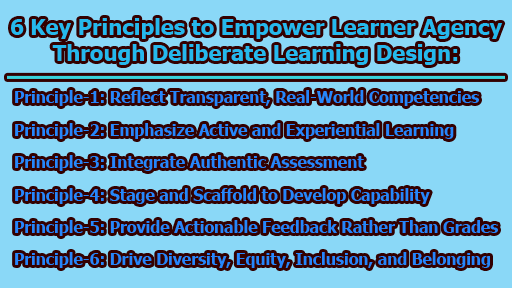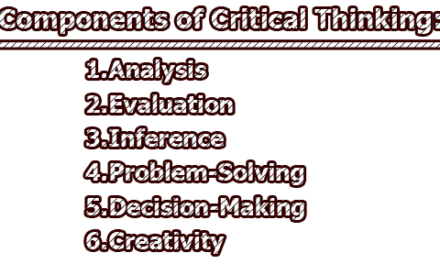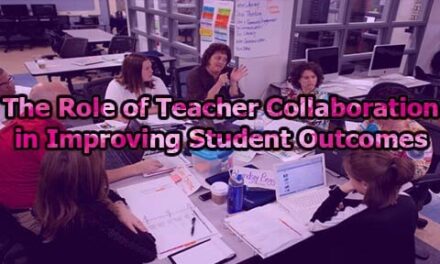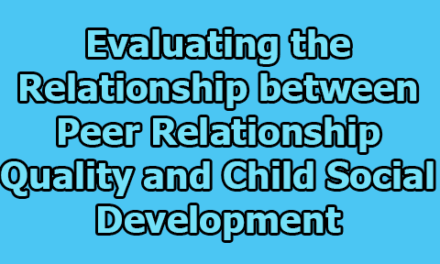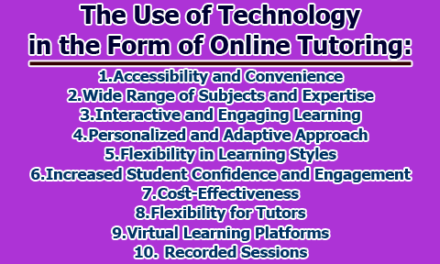6 Key Principles to Empower Learner Agency through Deliberate Learning Design:
In the realm of education, fostering learner agency has emerged as a critical goal. Learner agency refers to the capacity of learners to take an active and self-directed role in their education, making choices and decisions that influence their learning journey. To achieve this, intentional learning design plays a pivotal role. In this article, we will delve into 6 key principles to empower learner agency through deliberate learning design.
Principle-1: Reflect Transparent, Real-World Competencies: In the pursuit of learner agency, the first principle revolves around the establishment of clear, real-world competencies. These competencies serve as the foundational framework upon which the entire learning experience is built. They are not shrouded in ambiguity; rather, they are transparent and easily comprehensible, both for educators and learners themselves.
Transparent competencies act as guiding beacons, illuminating the path for learners, making it apparent what skills, knowledge, and capabilities they will acquire throughout their educational journey. This clarity empowers learners to see the relevance of their education and to set tangible, achievable learning objectives (Smith & Johnson, 2020).
Principle-2: Emphasize Active and Experiential Learning: The second principle champions active and experiential learning as cornerstones of learner agency. Active learning invites learners to participate actively in the learning process, moving beyond passive reception of information. It encourages them to think critically, engage in problem-solving, and contribute to discussions actively.
Experiential learning elevates this concept by infusing real-life experiences into the educational journey. Learners are provided with opportunities to apply theoretical knowledge in practical, real-world situations, such as internships, projects, or simulations. These experiences not only deepen understanding but also empower learners to proactively seek knowledge and real-world exposure (Brown & Davis, 2019).
Principle-3: Integrate Authentic Assessment as a Key Component of Learning: Authentic assessment takes center stage as the third principle, serving as a linchpin for learner agency. Rather than relying solely on traditional testing methods, authentic assessments mirror real-world tasks and challenges. They ask learners to apply their acquired competencies in genuine, practical contexts.
These assessments might manifest as project-based assignments, case studies, or performance tasks, each designed to assess a learner’s ability to thrive in authentic, real-world scenarios. By engaging in authentic assessments, learners perceive a direct link between their educational efforts and tangible future success, fueling their motivation and self-directed learning (Jones et al., 2021).
Principle-4: Stage and Scaffold to Develop Capability: The fourth principle recognizes that learners need structure and support to develop agency effectively. Staging involves breaking down complex concepts or skills into manageable, logical stages. It allows learners to build their capabilities progressively, avoiding overwhelm and frustration. According to Blaschke (2016), heutagogy brings together five guiding principles:
- Learner agency: The student is the primary agent of their learning, with the learner making decisions about learning, from what will be learned and how, to whether learning has been achieved and to what degree (e.g., self-assessment).
- Self-efficacy and capability: The learner has self-efficacy, belief in their own abilities, and capability, the ability to demonstrate an acquired competency or skill in new and unique environments.
- Metacognition and reflection: The learner reflects upon and critically thinks about what has been learned and the process of learning, in the form of double-loop learning (metacognition).
- Non-linear learning: The learner directs the learning path, which is not pre-defined or sequential, as the learner is responsible for identifying what will be learned and how.
- Learning how to learn: The student not only learns but also learns how to learn, preparing the learner for life outside the classroom.
Scaffolding complements staging by offering tailored support and guidance when learners encounter challenges. This support gradually diminishes as learners gain proficiency and confidence. This approach ensures that learners are not left to fend for themselves but are supported at each stage, fostering a sense of agency and self-efficacy (Roberts & Green, 2018).
Principle-5: Provide Actionable Feedback Rather Than Grades: The fifth principle reimagines the role of assessment by emphasizing feedback over grades. Instead of relying solely on grades as the end-all, educators provide learners with timely, specific, and actionable feedback.
This feedback serves as a roadmap for improvement, highlighting both strengths and areas for growth. It empowers learners to take ownership of their learning journey, promoting self-reflection and self-regulation (Miller & Adams, 2017). In this way, learners become active participants in their educational progress rather than passive recipients of evaluative judgments (Miller & Adams, 2017).
Principle-6: Drive Diversity, Equity, Inclusion, and Belonging: The final principle underscores the importance of fostering a diverse, equitable, inclusive, and welcoming learning environment. Learner agency thrives when every learner feels valued, respected, and included.
This inclusivity acknowledges and celebrates the unique backgrounds, experiences, and perspectives of each learner. It creates a supportive community where agency flourishes as learners are motivated to engage and contribute their individual strengths (Garcia & Hernandez, 2020).
It is apparent that empowering learner agency through intentional learning design is essential for equipping students with the skills and mindset necessary for success in the rapidly evolving world. By incorporating these six principles into their instructional strategies, educators can foster a sense of ownership, motivation, and self-directed learning among their students. Furthermore, these principles promote the development of lifelong learners who are adaptable and well-prepared to navigate the complexities of the real world.
References:
- Blaschke, L. M. (2016). Strategies for implementing self-determined learning (heutagogy) within education: A comparison of three institutions (Australia, South Africa, and Israel) [Unpublished master’s thesis]. Carl von Ossietzky Universität Oldenburg.
- Brown, A., & Davis, K. (2019). Active learning. In Encyclopedia of Education Economics and Finance (pp. 1-5). Springer.
- Garcia, M. E., & Hernandez, C. R. (2020). Fostering diversity, equity, and inclusion in the classroom: Strategies and reflections. Harvard Education Press.
- Jones, L. L., et al. (2021). Authentic assessment in the classroom: Applications and examples. Routledge.
- Miller, A., & Adams, C. (2017). A comparison of student perceptions of actionable feedback in the online and face-to-face classroom. International Journal of e-Education, e-Business, e-Management, and e-Learning, 7(5), 312-316.
- Roberts, P., & Green, G. (2018). Scaffolding: Promoting successful learning in the classroom. Routledge.
- Smith, J. R., & Johnson, L. K. (2020). Competency-based education: A framework for measuring quality courses. Online Learning, 24(4), 82-95.

Library Lecturer at Nurul Amin Degree College

